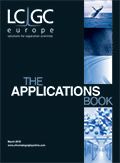Assessing Antibody ADCC Activity by Affinity HPLC
The Application Notebook
Antibody-dependent cell-mediated cytotoxicity (ADCC) is a crucial mechanism of action (MoA) of anti-tumour therapeutic antibodies and FcγIIIa receptor plays a key role in this process by interacting with the N-glycans of IgG Fc regions. Hence, affinity chromatography on Fc receptor ligands can deliver valuable information about expected ADCC activity and mAb glycoform distribution.
Antibody-dependent cell-mediated cytotoxicity (ADCC) is a crucial mechanism of action (MoA) of anti-tumour therapeutic antibodies and FcγIIIa receptor plays a key role in this process by interacting with the N-glycans of IgG Fc regions. Hence, affinity chromatography on Fc receptor ligands can deliver valuable information about expected ADCC activity and mAb glycoform distribution.
A new HPLC column, TSKgel FcR-IIIA-NPR, is based on a recombinant FcγIIIa receptor ligand and allows fast assessment of biologic activity of monoclonal antibodies (mAbs). As Fc-glycans of antibodies are known to play an important role in Fc-mediated interactions, the separation pattern of mAbs on TSKgel FcR-IIIAâNPR can be correlated to FC-glycans as well (1). Terminal galactose residues increase affinity to FcγRIIIa while core fucose residues reduce it. This correlates with the known influence of galactose and fucose on antibody-dependent cell-mediated cytotoxicity (ADCC) activity. Accordingly, early eluting peaks of TSKgel FcR-IIIA-NPR represent glycoforms with low ADCC activity, while late eluting peaks represent glycoforms with high ADCC activity (Figure 1).
Separation of mAb Glycoforms
Figure 2 demonstrates the specificity of the recombinant FcγRIIIA ligand for N-glycans of the Fc domain of mAbs. Adalimumab analyzed with TSKgel FcR-IIIA-NPR shows a typical pattern of three peaks, corresponding with the molecule’s glycan heterogeneity. Treatment of adalimumab with PNGase F de-glycosylates the sample. De-glycosylated adalimumab does not bind to TSKgel FcRâIIIA-NPR; the N-glycan related peaks are absent.
HPLC Conditions
Column: TSKgel FcR-IIIA-NPR (4.6 mm × 7.5 cm L, 5-µm)
Mobile Phase:
A: 50 mmol/L sodium citrate, pH 6.5;
B: 50 mmol/L sodium citrate, pH 4.5
Flow Rate: 1 mL/min
Temp.: 25 °C
Detection: UV @ 280 nm
Sample: 50 µL of adalimumab or PNGase F treated adalimumab (1 µg/µL)
Conclusion
A rapid 30-min separation on TSKgel FcR-IIIA-NPR allows the analysis of large numbers of mAb samples to gain valuable first information on the distribution of glycoforms and expected ADCC activity. This fast and efficient method can be applied to purified samples and supernatant alike and can be used in many phases of development and production such as cell line screening in early R&D, biosimilar or originator comparison, upstream development and optimization, monitoring of glycoengineering, or lot-to-lot comparison in QC.
Reference
- M. Kiyoshi et al., Sci. Rep.8, 3955 (2018) doi:10:1038/s41598-018-22199-8
- TSKgel is a registered trademark of Tosoh Corporation

Tosoh Bioscience GmbH
Im Leuschnerpark 4 64347 Griesheim, Darmstadt, Germany
Tel: +49 6155 7043700 Fax: +49 6155 8357900
E-mail: info.tbg@tosoh.com
Website: www.tosohbioscience.de

Determining Enhanced Sensitivity to Odors due to Anxiety-Associated Chemosignals with GC
May 8th 2025Based on their hypothesis that smelling anxiety chemosignals can, like visual anxiety induction, lead to an increase in odor sensitivity, a joint study between the University of Erlangen-Nuremberg (Erlangen, Germany) and the Fraunhofer Institute for Process Engineering and Packaging (Freising, Germany) combined behavioral experiments, odor profile analysis by a trained panel, and instrumental analysis of odorants (gas chromatography-olfactometry) and volatiles (gas chromatography-mass spectrometry).
Investigating 3D-Printable Stationary Phases in Liquid Chromatography
May 7th 20253D printing technology has potential in chromatography, but a major challenge is developing materials with both high porosity and robust mechanical properties. Recently, scientists compared the separation performances of eight different 3D printable stationary phases.
Detecting Hyper-Fast Chromatographic Peaks Using Ion Mobility Spectrometry
May 6th 2025Ion mobility spectrometers can detect trace compounds quickly, though they can face various issues with detecting certain peaks. University of Hannover scientists created a new system for resolving hyper-fast gas chromatography (GC) peaks.

.png&w=3840&q=75)

.png&w=3840&q=75)



.png&w=3840&q=75)



.png&w=3840&q=75)










